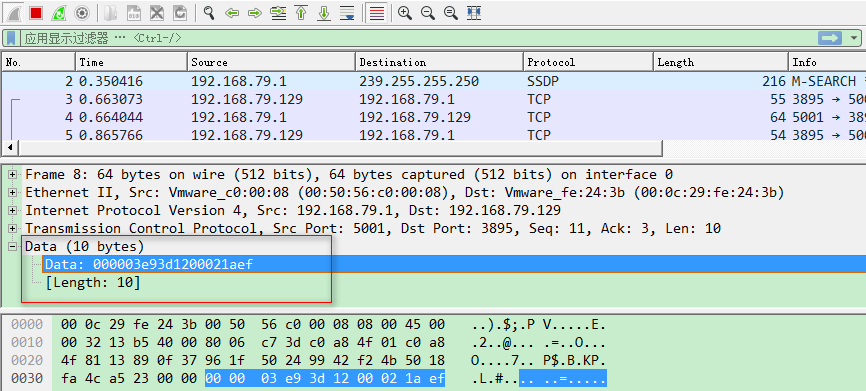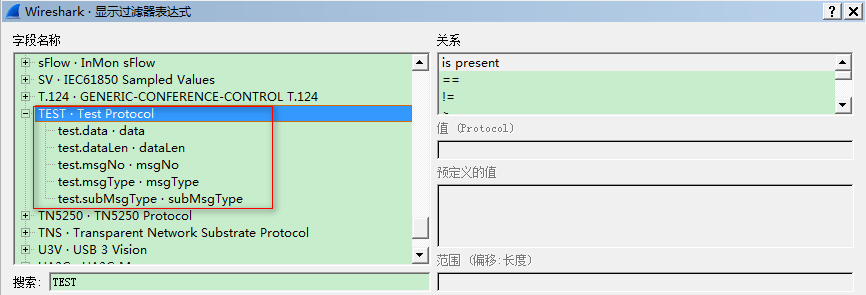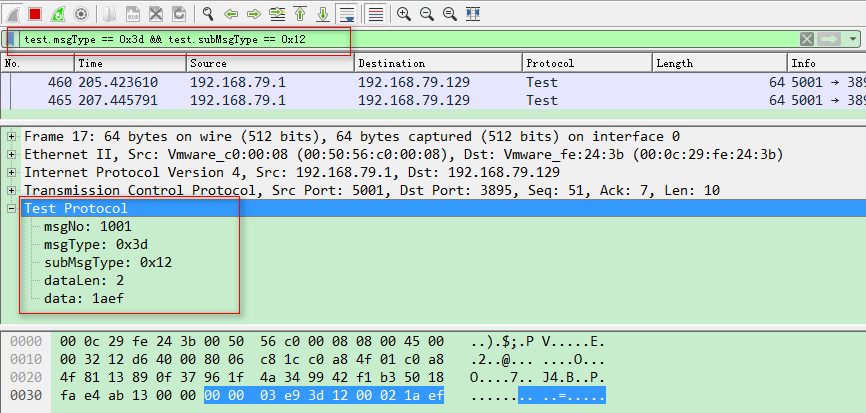在平时的工作中,经常需要根据接口文档进行开发,在调试时一般都会借助WireShark抓包进行分析,但是当协议较为复杂时,需要根据字节数手动计算进行解析,费时费力。曾经打算自己写个简单的自定义协议解析工具,后来发现WireShark提供了Lua接口,可以通过Lua脚本根据协议格式自动对获取的数据报进行解析,本文将对此进行简要介绍。
自定义协议格式
#pragma pack(1)
struct MsgHead {
int msgNo_;
unsigned char msgType_;
unsigned char subMsgType_;
short dataLen_;
};
struct MsgStruct {
MsgHead msgHead_;
unsigned char data_[MaxDataSize];
};
#pragma pack()
原始抓包结果

编写Lua脚本
-- creates a Proto object, but doesn't register it yet
local test_proto = Proto("test", "Test Protocol")
-- a table of all of our Protocol's fields
local test_fields =
{
msgNo = ProtoField.uint32("test.msgNo", "msgNo", base.DEC),
msgType = ProtoField.uint8("test.msgType", "msgType", base.HEX),
subMsgType = ProtoField.uint8("test.subMsgType", "subMsgType", base.HEX),
dataLen = ProtoField.uint16("test.dataLen", "dataLen", base.DEC),
data = ProtoField.bytes("test.data", "data"),
}
-- register the ProtoFields
test_proto.fields = test_fields
-- a table of our default settings - these can be changed by changing
-- the preferences through the GUI or command-line; the Lua-side of that
-- preference handling is at the end of this script file
local default_settings =
{
enabled = true, -- whether this dissector is enabled or not
port = 5001, -- default TCP port number for Test
}
--------------------------------------------------------------------------------
-- The following creates the callback function for the dissector.
-- It's the same as doing "test_proto.dissector = function (tvbuf,pkt,root)"
-- The 'tvbuf' is a Tvb object, 'pktinfo' is a Pinfo object, and 'root' is a TreeItem object.
-- Whenever Wireshark dissects a packet that our Proto is hooked into, it will call
-- this function and pass it these arguments for the packet it's dissecting.
function test_proto.dissector(tvbuf, pktinfo, root)
-- set the protocol column to show our protocol name
pktinfo.cols.protocol:set("Test")
-- get the length of the packet buffer (Tvb).
local pktlen = tvbuf:len()
local offset = 0
-- We start by adding our protocol to the dissection display tree.
local tree = root:add(test_proto, tvbuf:range(offset, pktlen))
tree:add(test_fields.msgNo, tvbuf(offset, 4))
offset = offset + 4
tree:add(test_fields.msgType, tvbuf(offset, 1))
offset = offset + 1
tree:add(test_fields.subMsgType, tvbuf(offset, 1))
offset = offset + 1
tree:add(test_fields.dataLen, tvbuf(offset, 2))
offset = offset + 2
tree:add(test_fields.data, tvbuf(offset, pktlen-offset))
end
--------------------------------------------------------------------------------
-- We want to have our protocol dissection invoked for a specific TCP port,
-- so get the TCP dissector table and add our protocol to it.
local function enableDissector()
-- using DissectorTable:set() removes existing dissector(s), whereas the
-- DissectorTable:add() one adds ours before any existing ones, but
-- leaves the other ones alone, which is better
DissectorTable.get("tcp.port"):add(default_settings.port, test_proto)
end
local function disableDissector()
DissectorTable.get("tcp.port"):remove(default_settings.port, test_proto)
end
-- call it now
enableDissector()
完整程序详见:https://github.com/AnonymousRookie/useful-tools/tree/master/wireshark_protocol_dissector
在Wireshark中加载Lua脚本
将protocol_dissector_example.lua拷贝到Wireshark的安装目录,找到init.lua,在该脚本结尾加上:
dofile(DATA_DIR.."protocol_dissector_example.lua")
重启Wireshark,点击按钮”表达式…/(Expression…)”,在搜索框中输入”TEST”,发现”Test Protocol”,说明脚本已经加载成功。

在Wireshark中查看解析结果
现在就可以根据协议格式进行筛选了,并且获取到的数据报已经根据定义的格式自动进行了解析。

参考文献
- [1] https://wiki.wireshark.org/Lua/Examples